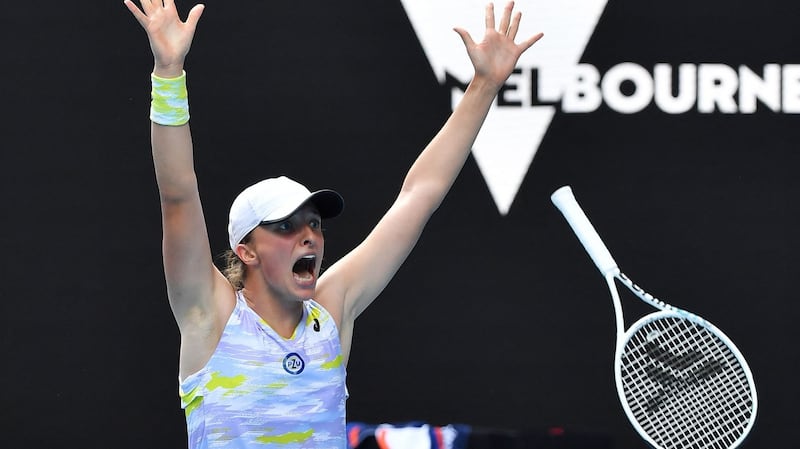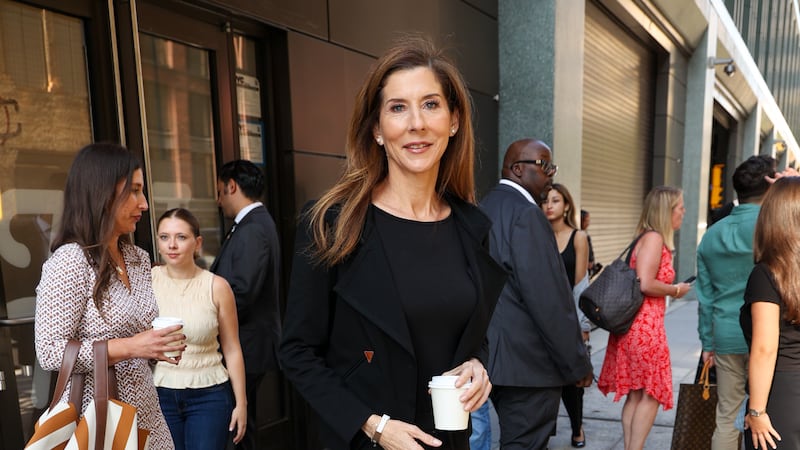Last year Poland’s Iga Swiatek occupied most of the head space in tennis talking shops and betting shop chatter. No surprise. She will again at this year’s Australian Open. But it is Ons Jabeur who will continue something just as eye-catching with her cultural crusade entering its second year and maybe a major title.
Two Grand Slam singles finals in 2022 represented a first-time achievement by an Arab woman. Jabeur is in a place now where anything is possible and refixing focus on the next stage of her history scroll is in advanced draft stage.
Using the same Vogue magazine as Serena Williams did last year, when she told the world she had decided to “evolve away” from tennis, so too was Vogue Africa the preferred vehicle this month for the announcement of the coming again of Jabeur. A new year, the same goal.
Since becoming a top player her tennis, a mix of touch, net play and clever angled shots around court, has always come with messaging and inspirational zeal, enough at least to embolden other African and Arab women that tennis is a viable option.
RM Block
The sport has always courted fashion and glamour, with the photograph of Jabeur soberly dressed siting on a straight-backed chair with a racket. Sketching a picture of success, one caption reads “Top, pants, earrings, necklace, Prada”.
In another she wears a long, green, heavy coat which almost touches the floor captioned “Coat, Elie Saab; earrings, Boucheron”. In another and back on a chair her dressers are: “Suit, top, Stella McCartney; shoes, Christian Dior”.
The modern Arab woman, posters of Jabeur adorn Tunisia’s capital, Tunis. She is by far the hottest prospect in that side of the world to win a Grand Slam this year. Jabeur and the world number 53, Mayar Sherif, from Egypt, are the only two players in the top 100 from an African country.
But she and Swiatek have managed to fill the vacuum left by the departures of two of the highest-profile players, Ashleigh Barty and Naomi Osaka. How long Osaka will remain away depends on her mood after pregnancy, which has ruled her out for 2023, while Barty’s no-fuss retirement last year also hurt the depth of the women’s game.
[ Kazak and Tunisian in Wimbledon final — the changing face of women’s tennisOpens in new window ]
The arrival of Swiatek and Jabeur was highlighted in 2022 in the last major final of the year, the US Open. The number one, Swiatek, who had a 37-match winning streak end at Wimbledon, and Jabeur met in what many hope can be the beginnings of a major new rivalry in tennis.
While Swiatek is just 21-years-old, those ranked beneath her are at an age where their first Grand Slam win can’t come quick enough. Third-ranked American Jessica Pegula, like second seed Jabeur, is 28-years-old, while fourth-ranked Caroline Garcia is 29.
Female teen tennis players, for now, is not in fashion with just the world number seven, Coco Gauff at 18, the only player under 20 years old in the world top 50.

“Every person has a different path, and every person takes their own time,” said Jabeur. “They might go in super-fast and win something huge, but I have taken my time to understand the tour. Definitely, things have happened slowly with me but then 2022 was the best year of my life.
“I’m someone from Tunisia and nobody believed I could be at Wimbledon as the world number two. That’s the message I’m always trying to send. If you’re mentally strong, you can do anything.”
Her rise in tennis will also be framed in a new Netflix fly-on-the-wall documentary Break Point that debuts this month. Made by the team behind F1: Drive To Survive, the programme will chronicle life on the road during the 2022 tennis season across the men’s and women’s tours.
But good as Jabeur’s season was, last year Swiatek captured two Grand Slams, won eight of her nine finals, and set a new record for the most consecutive wins on the WTA Tour in the 21st century with the 37-match streak.
She is the new boss, although has yet to hold the court presence or physical threat of Serena Williams, who instantly owned and dominated the environment whenever she appeared. Always the queen bee, there is nobody yet in women’s tennis who possesses such menace.
Others in the plot include Kazak Elena Rybakina. Kazakhan’s buy-in attitude has served them more than well. The 23-year-old previously represented Russia but switched her nationality in 2018 to take advantage of greater financial support.
Because of that, the dedicated baseliner and No 22 seed, successfully sidestepped last year’s Wimbledon ban on Russian players before beating Jabeur on final day for her one and only major title.
Of the Americans just Gauff, seeded eight and Madison Keyes two rungs down, are among the top 10 players in the draw.
If culture wars on the women’s side are ripping along, so too are they in the men’s draw. Novak Djokovak is back, which is good for tennis. His deportation last year has not made him any more humble. He is the best Australian Open player in the field, although Rafa Nadal is installed as the top seed.
Djokovic has won in Australian nine times before, although on Wednesday he threw the organisers into paroxysms when he cut short a practice match with Daniil Medvedev due to hamstring twinge. Good news is he found a new enemy, the media. That could be a great motivator.
The Serb, seeded four, initially tweaked the muscle during his run to the Adelaide International title last week. Speaking to Australian media he said: “I just felt it pulling and I didn’t want to risk anything worse.”

But last year’s vaccine spat has been forgiven and forgotten as he returns to his most successful arena.
“I love playing in Australia. I mean, my results are a testament to that,” he said last week. “I wouldn’t be able to play so well in a place where I don’t feel well. I look forward to Melbourne. Rod Laver is probably my most – not probably, it certainly is my most successful court in my career. I love playing there. I look forward to it.”
Nadal’s last competition was the inaugural United Cup, an 18-team mixed competition that ended on Sunday. It was played across three Australian cities and won by the USA. For the top seed it was a mixed bag.
He lost twice but saw enough to build on before he faces the dangerous young Jack Draper in a first round generational tussle of the 21-year-old against the 36-year-old.
“Physically was not that bad,” said Nadal last weekend. “I need to, as I said the other day, I need to be a little bit faster, a little bit more dynamic on court, to read a little bit better the ball. That gives you the confidence, the hours on court, playing matches, and that’s it. In terms of physical issues, I can’t complain. Happy for that. That helps a lot to keep going.
“I just believe that the situation is how it is and I have to improve. That’s it, no. I really believe it’s gonna happen. When? I don’t know. But I really hope that it’s gonna happen soon, because I don’t feel that I am that far [away].”
Norwegian Casper Ruud and Stefanos Tsitsipas from Greece are sandwiched in the seeding between Nadal and Djokovic at four. Both are looking for their first Grand Slam win.
Over the last six years and 24 Grand Slam events just three players outside Djokovic, Nadal and Roger Federer have won. Carlos Alcarez, last year’s US Open champion, is injured and will not play in Melbourne.
Daniil Medvedev won the 2021 US Open and is seeded seven, while Dominic Thiem, who won the 2020 US Open, is a wildcard entry. Working his way back from a wrist injury after losing ranking protection, Thiem has been drawn against fifth seed, Andrey Rublev, in the first round.
It could be safely said that neither player in that match-up will be particularly pleased to face such a challenging opponent.
If there are general themes at play, one is whether Swiatek is ready to assume the grip Williams had on the women’s game, or, allow Jabeur her slice of history.
Among the men, Nadal must challenge Djokovic who is striking out for his 10th Australian Open, Grand Slam number 22. Then the Spaniard and Serb would stand side by side as equals.





















